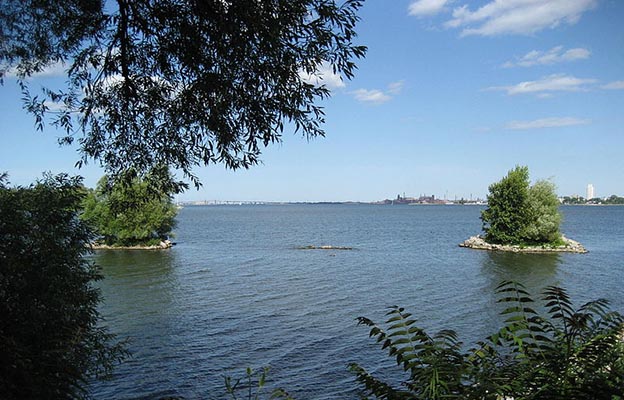Waste not, want not: Students examine how we use and abuse fresh water

Think globally, act locally: Breaking into teams of three or four, students in Maureen Padden's third-year Sustainability and the Economy class examined how to reduce mounting pressure on Hamilton's wastewater treatment facilities. The teams also studied how those facilities are linked to Hamilton Harbour.
For those who like to begin their day with a piping-hot shower, adding a few extra minutes can seem like a harmless indulgence.
Unfortunately, the cost of relaxation is high.
According to new research from a team of McMaster students, the average household in Hamilton spends roughly $1,200 per year on costs related to regular 10-minute showers.
Heating the water for those showers also adds to Canada’s greenhouse gas emissions, and the high volume of liquid pouring down the drain can place a large burden on Hamilton’s wastewater facilities.
For students in Maureen Padden’s third-year Sustainability and the Economy class, tackling such water-related issues became the focus of an innovative multi-week assignment that fused experiential learning with theoretical know-how.
McMaster associate professor Maureen Padden
The students, who studied with Padden during the winter term, recently began sharing their findings on Hamilton’s Bay Area Restoration Council website.
“The assignment provided an opportunity for students to really go deep into an issue,” said Padden, an associate professor who joined the University in 2008. “Working on an assignment like this one, students are more likely understand the broad issues I’m teaching in class.”
Breaking into teams of three or four, Padden’s students examined how to reduce mounting pressure on Hamilton’s wastewater treatment facilities. The teams also studied how those facilities are linked to Hamilton Harbour.
The students conducted research based on four themes — neighbourhoods, storm water, water waste in bathrooms and domestic chemicals. The teams were then tasked with developing a strategy for an average household to reduce pressure on the wastewater treatment plant in one of those areas.
Part of the challenge, explained Padden, is that the strategy must be economically feasible for most residents in Hamilton. For example, one group studied the efficiency and practicality of using Swedish-made Orbital Systems for showering.
According to fourth-year student Winnie Chan, the system uses uses a “closed-loop water system” that recycles shower water.
“Water comes out from the shower nozzle and trickles down to the shower tray which holds a water filter, purifies the used water and pumps it back up to the nozzle,” wrote Chan, in a recent blog post for the Bay Area Restoration Council. When used correctly, the system could save the average Hamilton household nearly $1,000 per year on water and energy costs.
Below: research from Chan illustrates how an average Hamilton family that showers with an water-recycling system could save roughly $1,000 per year:
During the winter term, guest speakers from the Bay Area Restoration Council and a local watershed stewardship organization also visited Padden’s classroom to discuss their role in the Remedial Action Plan — a long-term strategy involving government, industrial and environmental partners to delist Hamilton Harbour as an “Area of Concern” in the Great Lakes region.
Interestingly, Padden has posted the assignment description online for free, with the hope that other postsecondary institutions across Canada and the United States will take her model and adapt it to their own surroundings.
The long-term goal, explained Padden, is to challenge students to think critically and formulate a convincing argument, no matter which side of the debate they land on.
“The ‘right thing to do’ changes all the time,” she explained. “But ultimately, I want students to be able to defend their position with hard evidence. It’s a great skill to have, especially when the issues hit close to home.”
This fall, Padden will be introducing a lab in a first-year class called Earth and the Environment, with a focus on studying the hydrology of a local creek on campus.
Students will measure water levels in groundwater wells, and will also study the velocity and amount of water moving in the creek, chemical parameters and other variables. The data will then be used by students in an upper-year field-based hydrology course, led by McMaster geography professor Mike Waddington.



